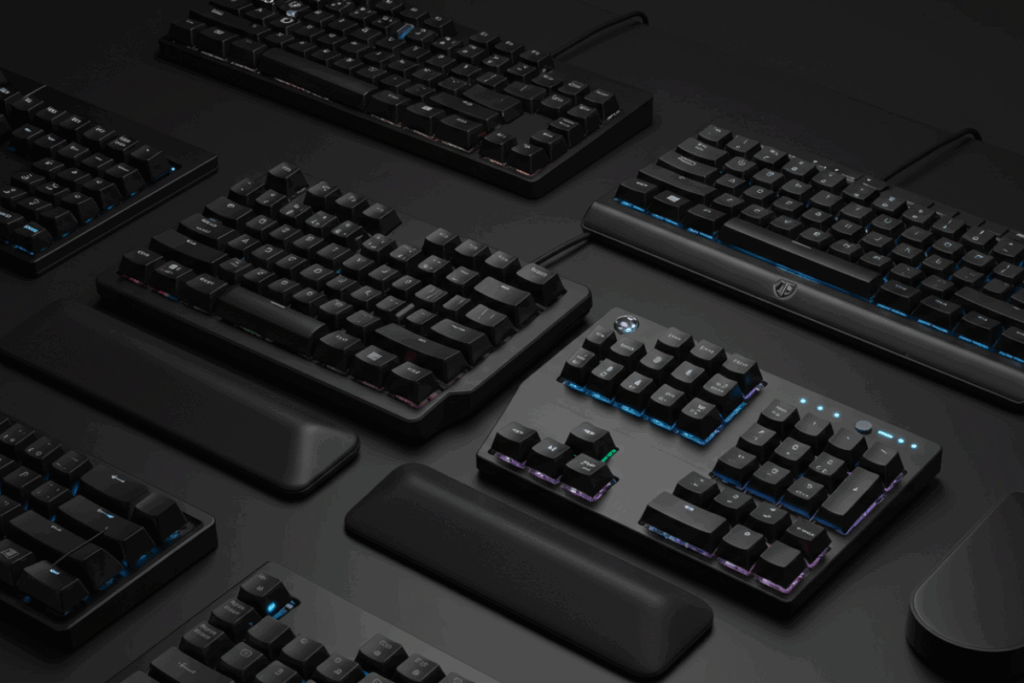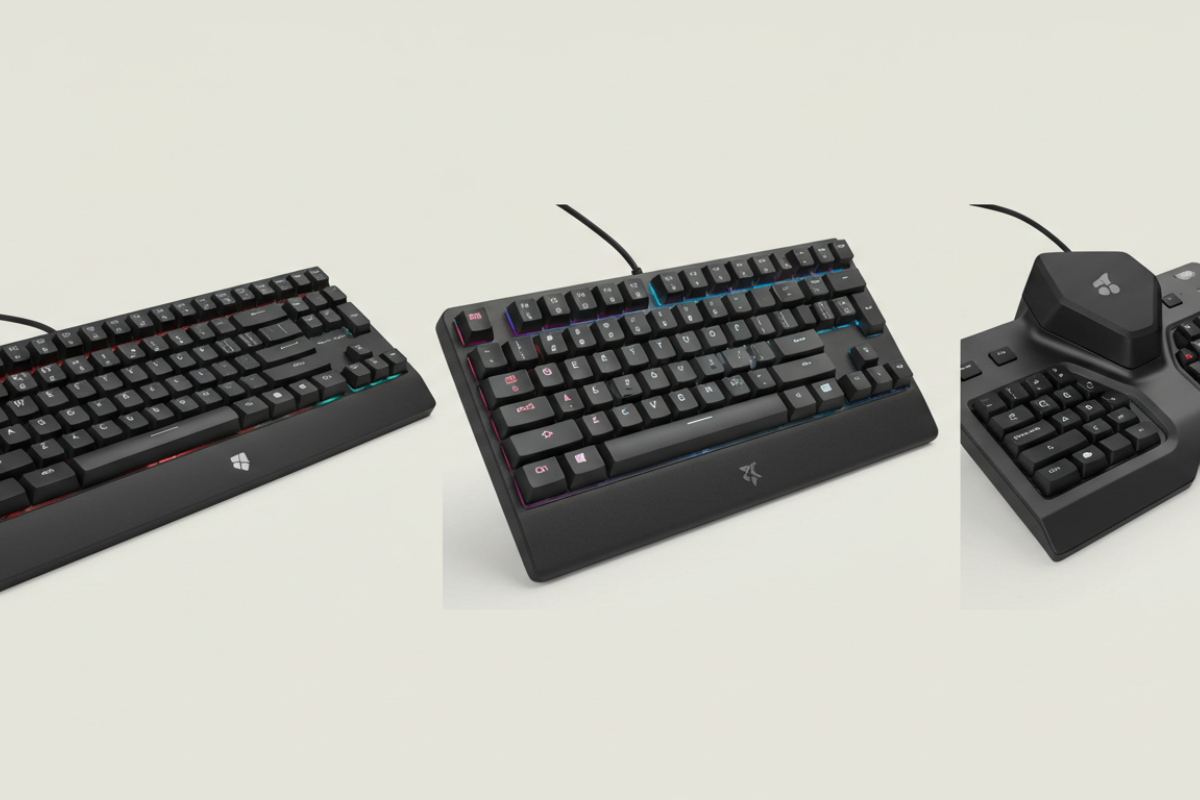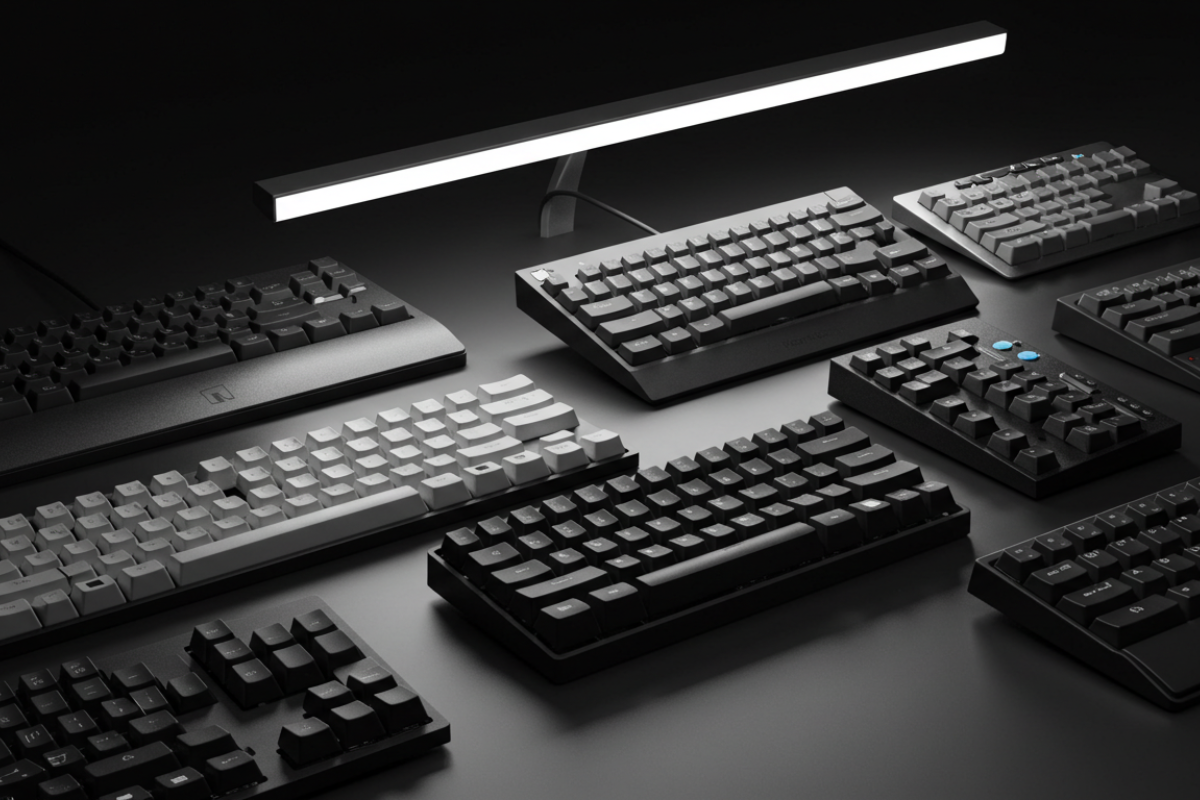Bbest keyboards for Windows users start with the right layout and driver support. At Keyboards Technology I test for Windows key placement, Fn behavior, switch feel, connectivity, latency, battery life, and software.
Below are my top picks and a concise buying and care guide so you get the keyboard that fits your Windows setup.
Key Takeaway
- I choose Keyboards Technology models for accurate Windows key layout.
- Their keycaps and legends match Windows shortcuts, which reduces errors.
- Easy Windows software and clean drivers speed setup.
- Better layout good switches = faster typing and fewer mistakes.
- Mid-range models often deliver the best value among the best keyboards for Windows users.
Why I recommend specific keyboards for Windows users
Windows layout, shortcuts, and key labeling that matter
I pick keyboards by how well their layout matches Windows habits. The Windows key must sit where muscle memory expects it. Clear legends for Ctrl, Alt, Win, and Menu are essential — Mac icons or swapped labels break workflow.
Common layouts and who they suit:
| Layout / Label | What I notice | Who benefits |
|---|---|---|
| ANSI (US) | Big Enter, familiar left Shift | Most Windows typists |
| ISO (EU) | Tall Enter, extra key near left Shift | Users in EU layouts |
| Windows-labeled keycaps | Shows Win and shortcuts | Users switching from OEM boards |
| Secondary legends | Media or macro labels | Power users who rely on shortcuts |
I once bought a keyboard with swapped Alt and Fn — it looked neat but slowed me down. That taught me to favor boards that prioritize clear Windows legends and standard layouts.
Driver and software compatibility with Windows 10 and 11
I prefer keyboards that work immediately on Windows 10 and Windows 11. Plug-and-play is great, but a signed, stable companion app for macros and lighting is useful. Before buying I check:
- Is it plug-and-play or needs a driver?
- Can I remap keys in the app?
- Are firmware updates simple on Windows?
| Feature | Why it matters | Example |
|---|---|---|
| Plug-and-play | Start typing immediately | Saves time at work |
| Official Windows app | Easy remaps and lighting control | Assign media keys to F-keys |
| Signed drivers / x64 support | No weird Windows warnings | Smooth firmware updates |
A timely firmware patch once fixed my ghosting issue on Windows 11. That’s the kind of reliability I expect from the brands I recommend among the best keyboards for Windows users.
Media and function key behavior
Media vs. F-keys is a real preference. If I’m in meetings I want media keys; if I’m coding I want true F-keys. Look for:
- Fn lock or BIOS toggle to flip default behavior.
- Dedicated media controls or a volume knob.
- Quick Windows media support (play, pause, volume).
| Behavior | Why it matters | My preference |
|---|---|---|
| Media-first by default | Quick audio control in calls | Good for remote work |
| F-key-first by default | Needed for dev tools | Good for programmers |
| Dedicated controls | No modifier needed | Best for mixed tasks |
That small volume knob can be the cherry on top for daily use.
Key features I check when picking the best keyboards for Windows users
Layout, Windows key placement, and Fn key behavior
Start with layout: full-size, TKL (tenkeyless), or compact. Full-size keeps the numpad for spreadsheets; TKL saves desk space; compact boards are travel-friendly. The Windows key placement should be near Alt for easy shortcuts. I prefer boards where the Fn layer is programmable and where I can swap Fn and Ctrl if needed.
| Layout | Best for | Note |
|---|---|---|
| Full-size | Data entry, spreadsheets | Keeps the numpad |
| TKL | Gamers, minimal desk | My go-to for daily use |
| 60% / 65% | Travel, small desks | Fits in a laptop bag |
Switch type, key rollover (NKRO), anti-ghosting, and latency
I pick switch type by feel: tactile for typing, lighter linear for gaming. Mechanical switches offer a distinct feel; scissor/membrane are quieter. Always check NKRO and anti-ghosting — for gaming and fast typing I want full NKRO. Wired USB is fastest for latency, but modern wireless can be close.
| Switch Type | Feel | Best use |
|---|---|---|
| Linear | Smooth, no bump | Fast-paced gaming |
| Tactile | Bump on actuation | Typing, mixed use |
| Clicky | Bump click sound | Writers who like feedback |
| Scissor/Membrane | Soft, quiet | Laptops, quiet spaces |
Connectivity: wired USB, Bluetooth, and 2.4 GHz
Wired USB wins for latency and power. Wireless options split into 2.4 GHz (dongle) and Bluetooth. Dongles give low latency; Bluetooth is great for multi-device switching. On Windows 10/11, prefer keyboards advertising strong driver support.
| Connection | Latency | Battery | Device switching | When I use it |
|---|---|---|---|---|
| Wired USB | Lowest | Uses PC power | N/A | Pro gaming, long sessions |
| 2.4 GHz dongle | Very low | Good | Limited | Fast wireless play |
| Bluetooth | Higher | Best battery | Best | Commuting, casual use |
I personally use a TKL wired board for desktop work and a Bluetooth compact for travel — both among the best keyboards for Windows users when matched to the task.
My top keyboards by category for Windows users
I test dozens of models. Here I share what I use and recommend for the best keyboards for Windows users, focusing on what I like, who it fits, and the trade-offs.

Best mechanical keyboards for Windows users
Mechanical keys give crisp, consistent typing. For Windows I want good key rollover, a clear Windows key layout, and switches that match my use.
| Type | Why I like it | Best for |
|---|---|---|
| Tactile (e.g., Brown-style) | Firm bump, reasonable noise | Typists wanting feedback without loud clacks |
| Clicky (e.g., Blue-style) | Loud, satisfying click | Writers who like auditory rhythm |
| Linear (e.g., Red-style) | Smooth, light press | Gamers and fast typists |
What I watch for:
- Switch lifespan: many advertise ~50M keystrokes.
- Windows layout: a full set of Windows keys and media controls.
- Build: metal plate or heavy base for stability.
If you want the best keyboards for Windows users, mechanical boards typically top the list for feel and durability.
Best wireless keyboards for Windows (Bluetooth and 2.4 GHz)
Wireless keyboards reduce desk clutter. For Windows 10/11 I want stable pairing, easy device switching, and long battery life.
| Connection | Strength | Typical drawback |
|---|---|---|
| Bluetooth | Works with laptops, tablets, phones | Some pairing lag on older devices |
| 2.4 GHz dongle | Very low latency | Uses a USB port |
| Multi-host (Bluetooth dongle) | Best of both worlds | Slightly pricier |
What I like:
- Profile switching to jump between PC and tablet.
- Full Windows key support and functioning shortcuts.
- Battery life: at least a month with backlight off for best practicality.
The best wireless options feel nearly as confident as wired ones when configured correctly, making them solid picks among the best keyboards for Windows users.
Best budget and compact keyboards for Windows laptops
Budget and compact boards can deliver strong value without sacrificing key features.
| Category | Recommendation | Reason |
|---|---|---|
| Budget full-size | Membrane or entry mechanical | Full Windows key set at low cost |
| Compact 60–75% | Compact layout with Windows keys or function layer | Saves desk space, portable |
| Travel keyboards | Slim Bluetooth mini with scissor switches | Lightweight and quiet for travel |
Key budget priorities:
- Reliable Windows shortcuts, even via function layer.
- Comfortable keycaps — flat cheap caps ruin the feel.
- Stability — a small board that slides around is unusable.
A compact Bluetooth board in my laptop bag improved my posture and editing speed on the go.
How I test and compare keyboards for Windows users
Typing feel: actuation force, travel, and noise
I type real text for at least 10 minutes per board, use a force gauge and phone sound app, then judge comfort, speed, and fatigue.
- Check actuation force per key. Lighter switches ease long typing; heavier ones reduce accidental presses.
- Measure travel and actuation point (mm).
- Record noise (dB) and rate office-friendliness.
| Metric | What I measure | What I look for |
|---|---|---|
| Actuation force | Light/medium/heavy (grams) | Light for long typing; medium for balance |
| Travel | Total travel and actuation point (mm) | Short for speed; longer for deliberate presses |
| Noise | dB subjective rating | Quiet for shared spaces; clicky for feedback |
Small gains in speed and accuracy matter for writers and coders. Consistent key spacing and reliable switch feel separate the best from the rest.
Gaming tests: polling rate, NKRO, and latency
I test shooters and macro-heavy games, toggling polling rate (125/250/500/1000 Hz) and measuring real input timing. I press many keys simultaneously to verify NKRO/anti-ghosting. A board that misses presses under load fails my gaming check.
| Polling rate | Interval (approx.) |
|---|---|
| 1000 Hz | ~1 ms |
| 500 Hz | ~2 ms |
| 250 Hz | ~4 ms |
| 125 Hz | ~8 ms |
The best gaming keyboards for Windows PC stay consistent at 1000 Hz and maintain low latency and stable macro performance.
Software, firmware updates, and mapping for programmers
I install the app, execute firmware updates (and rollback tests), and remap keys for coding workflows. I want per-key remap, layers, and onboard profile storage.
| Test | What I do | Why it matters |
|---|---|---|
| Firmware update | Update and rollback | Prevents bricked boards |
| Key mapping | Remap keys, create layers | Speeds common workflows |
| Onboard memory | Save profiles to device | Works without software on other PCs |
| Scripting / Macros | Create hotkeys for snippets | Speeds repetitive tasks |
| Windows stability | Reboot and check driver load | Avoids crashes and input loss |
Good mapping tools and reliable update processes are vital for devs — and a key selection factor when hunting the best keyboards for Windows users.
Buying guide I use to choose the right keyboard for Windows
Match keyboard type to use: office, coding, gaming, portability
Match the keyboard to what you do daily:
- Office: quiet, full-size with numpad and media keys.
- Coding: compact or TKL with tactile switches and sculpted keycaps.
- Gaming: low-latency, programmable keys, fast switches.
- Travel: small, lightweight with long battery life.
Check:
- Switch feel: tactile for typing, linear for gaming.
- Layout: full-size / TKL / 60% based on desk and workflow.
- Windows support: Windows key, media shortcuts, and driver support.
- Build: stable frame, good keycaps, hot-swap if desired.
A simple rule: match strengths to tasks and cut decision time.
Ergonomics: split and tenting options
Split keyboards, tenting, and wrist support can reduce pain. I test adjustability and key travel to reduce strain.
Look for:
- Split vs. single-piece: split for shoulder comfort.
- Tenting: adjustable to reduce forearm twist.
- Wrist support: firm, non-compressing pads.
- Key travel and force: low force for long typing.
For many users, an ergonomic split board is among the best ergonomic keyboards for Windows.
Budgeting and value (how I pick the top keyboards for Windows users in 2025)
I set a budget band and two non-negotiables, then pick top models that meet them.
| Budget tier | Price range | What I expect | Best use |
|---|---|---|---|
| Entry | <$50 | Solid membrane/basic mechanical, Windows keys | Casual typing |
| Mid | $50–$150 | Mechanical, TKL/full-size, some programmability | Coding, mixed work/gaming |
| Premium | $150 | Hot-swap, wireless wired, premium materials | Heavy typists, pro gamers |
Mid-range tends to offer the best value for most people searching the best keyboards for Windows users.
Setup and care tips I follow for Windows keyboards
Installing drivers, creating profiles, and mapping Windows shortcuts
Install the official driver first, let Windows update if requested, and create named profiles (Work/Gaming/Shortcuts). Map commonly used Windows shortcuts (screenshots, virtual desktops, favorite apps). For complex macros use the keyboard app; for quick remaps use AutoHotkey.
Driver/profile checklist:
| Step | What I do | Why it helps |
|---|---|---|
| Install driver | Run installer from vendor | Activates advanced features |
| Update firmware | Use keyboard app to flash | Fixes bugs and adds features |
| Create profiles | Make named profiles | Fast switching between tasks |
| Map shortcuts | Bind common Windows shortcuts | Cuts keystrokes, speeds work |
Test each profile for a day and tweak as needed.
Cleaning, replacing keycaps, and simple switch maintenance
Clean every few weeks with a keycap puller, soft brush, and compressed air. For sticky keys, soak keycaps in warm soapy water and dry fully. For hot-swappable boards, swap a failing switch; avoid opening switches unless experienced.
Cleaning tools:
| Tool | Use |
|---|---|
| Keycap puller | Remove caps safely |
| Soft brush | Sweep crumbs and dust |
| Compressed air | Blow out debris |
| Warm soapy water | Soak plastic keycaps |
| Microfiber cloth | Wipe frame and wrist rest |
A spilled coffee taught me to act fast — cleaning saved the board.
Battery life, Windows power settings, and long-term care for wireless keyboards
To extend battery life: turn off RGB, lower polling rate to 125 Hz if not needed, and tweak Windows power settings to avoid USB or Bluetooth sleep issues. Store wireless keyboards at ~50% charge and update firmware when available.
Power tweaks and effects:
| Change | Typical effect |
|---|---|
| Turn off RGB | 20–50% battery life |
| Lower polling rate | 10–30% battery life |
| Disable device sleep in Device Manager | Fewer disconnects |
| Avoid 0% long-term storage | Better battery health |
These small habits keep wireless boards responsive and long-lived.

Conclusion
Focus on layout and Windows key placement because muscle memory matters. Clean drivers and reliable software prevent shortcuts and firmware updates from tripping you up. Pick switches by feel — tactile for typing, linear for gaming — and always verify NKRO/anti-ghosting and latency.
Wired is best for rock-steady speed; wireless for portability and multi-device life. Ergonomics and mid-range mechanicals often deliver the best comfort and value among the best keyboards for Windows users.
Frequently Asked Questions
- What are the best keyboards for Windows users now?
I recommend full-size and TKL mechanicals with proper Windows legends and stable drivers — models from Keyboards Technology fit this well. - Wired or wireless — which is better for Windows users?
Wired for gaming and low lag; wireless for multi-device workflows. Many vendors now offer excellent options for both. - Which switch type should I pick for day-to-day use on Windows?
Tactile for balanced typing; linear for fast gaming. Choose by feel. - Do I need a full-size or compact keyboard for Windows?
Full-size if you need a numpad; TKL or 65% for tighter desks and better mouse positioning. - Are hot-swappable switches and software worth it for Windows users?
Yes. Hot-swap makes experimenting easy, and good software makes macros and lighting straightforward — both valuable among the best keyboards for Windows users.

